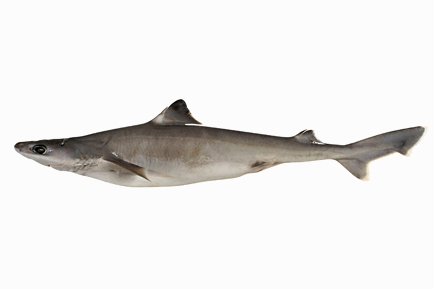Endeavour Dogfish, Centrophorus moluccensis Bleeker 1860
Other Names: Dogshark, Smallfin Gulper Shark, Southern Dogfish

Endeavour Dogfish, Centrophorus moluccensis. Source: Australian National Fish Collection, CSIRO. License: CC by Attribution-NonCommercial
Summary:
A pale greyish-brown to pearly-grey gulper shark becoming paler below, with black anterodorsal margins on the dorsal fins, a narrow pale rear margin on the caudal fin, and pale free rear pectoral-fin tips and first dorsal-fin base.
Cite this page as:
Bray, D.J. 2024, Centrophorus moluccensis in Fishes of Australia, accessed 10 Apr 2025, https://fishesofaustralia.net.au/home/species/3421
Endeavour Dogfish, Centrophorus moluccensis Bleeker 1860
More Info
|
Distribution |
West of Bunbury to north of Sahul Banks, Timor Sea, Western Australia, and the Townsville Trough, NE of Hinchinbrook Island, Queensland, to off Lakes Entrance, Victoria. The species is now rare south of Jervis Bay, New South Wales. Elsewhere the Endeavour Dogfish has a patchy distribution in the Indo-west Pacific. Demersal on continental and insular shelves and upper slopes at depths of 128–823 m. |
|
Features |
Snout moderately long and flat, preoral length 8–13% TL, ovate; upper teeth with a single, smooth-edged triangular cusp, relatively erect centrally in jaw, oblique laterally; lower teeth with oblique, serrated, blade-like cusps, cusps in males more erect and pointed. Lateral trunk denticles of adults with rhomboidal to nearly circular sessile crowns on very low thick pedicels, crowns close-spaced but not overlapping, with a short thorn-like to blunt medial cusp. Second dorsal fin very small, 2.0–2.4 in height of 1st dorsal fin, its spine well posterior to pelvic fin rear tips; free rear tip of pectoral fin forming an elongate lobe. |
|
Biology |
Attains a maximum size of 101.7 cm total length (TL). Males mature at ~70–90 cm TL; females mature at ~85–90 cm TL (Ebert et al. 2013). Reproduction is aplacental viviparous, fecundity is very low, with two pups per litter every two years, and size-at-birth estimated at 35–37 cm TL. |
|
Etymology |
The species is named for the type locality: the Molucca Islands, Indonesia. |
|
Species Citation |
Centrophorus moluccensis Bleeker 1860, Acta Societatis Scientiarum Indo-Neerlandicae 8: 3. Type locality: Ambon, Indonesia. |
|
Author |
Bray, D.J. 2024 |
|
Resources |
Endeavour Dogfish, Centrophorus moluccensis Bleeker 1860
References
Bleeker, P. 1860. Elfde bijdrage tot de kennis der vischfauna van Amboina. Acta Societatis Scientiarum Indo-Neerlandicae 8: 1-14
Compagno, L.J.V. 1984. FAO Species Catalogue. Sharks of the World. An annotated and illustrated catalogue of shark species known to date. Hexanchiformes to Lamniformes. FAO Fisheries Synopsis No. 125. Rome : FAO Vol. 4(1) pp. 1-249.
Compagno, L.J.V., Dando, M. & Fowler, S. 2005. A Field Guide to the Sharks of the World. London : Collins 368 pp.
Compagno, L.J.V. & Niem, V.H. 1998. Hexanchidae, Echinorhinidae, Squalidae. pp. 1208-1232 in Carpenter, K.E. & Niem, V.H. (eds). The Living Marine Resources of the Western Central Pacific. FAO Species Identification Guide for Fisheries Purposes. Rome : FAO Vol. 2 687-1396 pp.
Finucci, B., Bineesh, K.K., Cheok, J., Cotton, C.F., Dharmadi, Kulka, D.W., Neat, F.C., Pacoureau, N., Rigby, C.L., Tanaka, S. & Walker, T.I. 2020. Centrophorus moluccensis. The IUCN Red List of Threatened Species 2020: e.T42838A68614328. https://dx.doi.org/10.2305/IUCN.UK.2020-3.RLTS.T42838A68614328.en. Accessed on 03 July 2023.
Graham, K.J. & Daley, R.K. 2011. Distribution, reproduction and population structure of three gulper sharks (Centrophorus, Centrophoridae) in south-east Australian waters. Marine and Freshwater Research 62: 583–595
Grant, E.M. 2002. Guide to Fishes. Redcliffe : EM Grant Pty Ltd 880 pp. (as Centrophorus scalpratus)
Last, P.R. & Stevens, J.D. 1994. Sharks and Rays of Australia. Canberra : CSIRO Australia 513 pp. 84 pls.
Last, P.R. & Stevens, J.D. 2009. Sharks and Rays of Australia. Collingwood : CSIRO Publishing Australia 2, 550 pp.
Macbeth, W.G., Vandenberg, M. & Graham, K.J. 2008. Identifying Sharks and Rays; A guide to Commercial Fishers. Sydney : New South Wales Department of Primary Industry pp. 71.
McCulloch, A.R. 1915. Report on some fishes obtained by the F.I.S. Endeavour on the coasts of Queensland, New South Wales, Victoria, Tasmania, South and South-Western Australia. Part 3. Biological Results of the Fishing Experiments carried on by the F.I.S. Endeavour 1909-1914 3(3): 97-170 figs 1-3 pls 13-37 (described as Centrophorus scalpratus, type locality off Gabo Island, Victoria) See ref at BHL
Munro, I.S.R. 1961. Handbook of Australian fishes. Nos 1–42. Australian Fisheries Newsletter 15–17, 19, 20: 1-172
Stead, D.G. 1963. Sharks and Rays of Australian Seas. Sydney : Angus & Robertson 211 pp. 63 figs.
Stevens, J.D. 1994. Families Echinorhinidae, Squalidae, Oxynotidae, Parascyllidae, Orectolobidae. pp. 91-118 figs 28-73 in Gomon, M.F., Glover, C.J.M. & Kuiter, R.H. (eds). The Fishes of Australia's South Coast. Adelaide : State Printer 992 pp. 810 figs.
White, W. 2008. Shark Families Heterodontidae to Pristiophoridae. pp. 32-100 in Gomon, M.F., Bray, D.J. & Kuiter, R.H. (eds). Fishes of Australia's Southern Coast. Sydney : Reed New Holland 928 pp.
White, W.T., Ebert, D.A. & Naylor, G.J.P. 2017. Revision of the genus Centrophorus (Squaliformes: Centrophoridae): Part 2--Description of two new species of Centrophorus and clarification of the status of Centrophorus lusitanicus Barbosa du Bocage & de Brito Capello, 1864. Zootaxa 4344(1): 86-114 https://doi.org/10.11646/zootaxa.4344.1.3



